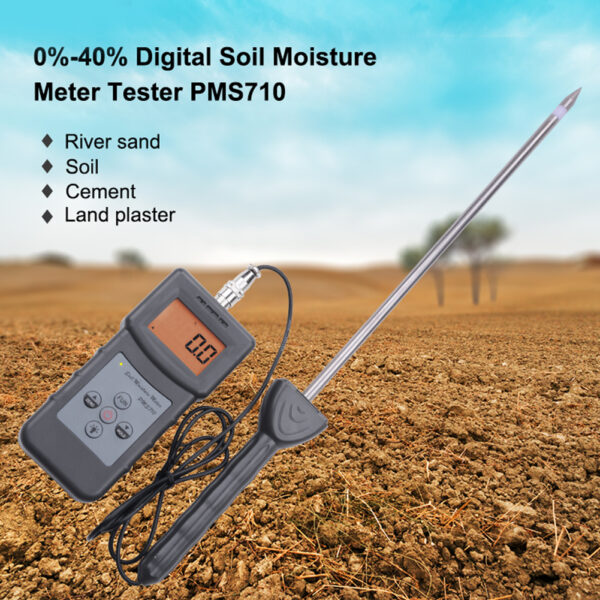The Science Behind Moisture Meters: How They Work and Why They're Essential
The Science Behind Moisture Meters: How They Work and Why They're Essential
Blog Article
Look Into the World of Moisture Meters: Whatever You Required to Know
In the world of moisture meters lies a world of accuracy and functionality that usually goes unnoticed. These tools, while apparently straightforward, hold a riches of information that can significantly affect different markets and applications. Understanding how moisture meters run, the various kinds available, and their diverse uses can drop light on their significance in making sure high quality and performance. By checking out the intricacies of dampness meters, one can reveal a valuable tool that transcends mere measurement, using understandings that can make a considerable difference in many areas.
How Moisture Meters Work
Moisture meters operate by gauging the electric conductivity or capacitance of materials to establish the wetness web content existing. These meters are very useful devices across numerous sectors, including agriculture, building, and woodworking. By using various techniques such as pinless or pin-type technology, dampness meters provide accurate analyses that aid experts make notified decisions.
Pin-type wetness meters function by inserting the sharp pins right into the material being checked. On the various other hand, pinless wetness meters utilize electro-magnetic signals to scan a bigger location without triggering any type of damage to the material's surface area.
No matter of the method made use of, moisture meters play a vital duty in avoiding issues such as mold and mildew development, architectural damage, or item flaws triggered by excess moisture. Comprehending how these meters job is vital for making sure the high quality and integrity of materials in various applications.
Types of Moisture Meters
Provided the vital function moisture meters play in numerous markets, it is vital to recognize the various kinds offered to experts for precisely analyzing wetness levels - Moisture Meter. There are largely 2 primary types of dampness meters: pinless and pin-type wetness meters

On the various other hand, pinless wetness meters make use of electromagnetic sensor plates to scan a bigger area of the product without causing any kind of damage. This type appropriates for swiftly scanning huge areas and is generally used for floor covering, walls, and ceilings. Pinless meters are practical for taking analyses on finished surfaces without leaving any kind of noticeable marks.
Both sorts of wetness meters have their benefits and are chosen based upon the details demands of the work handy. Comprehending the distinctions in between these types is critical for professionals to make precise dampness analyses.
Applications Across Industries
Building and construction experts count on dampness meters to evaluate the dampness levels in structure products like drywall, concrete, and timber, which is essential for keeping structural integrity and stopping issues like rot or mold. The flooring market makes use of wetness meters to gauge the wetness web content in subfloors before setting up various floor treatments, preventing pricey problems due to excess wetness. In the food sector, moisture meters are utilized to check and control moisture degrees in items such as grains, nuts, and dried fruits to preserve quality and quality.
Tips for Utilizing Wetness Meters
Make use of the More Help moisture meter's calibration settings to make certain accurate readings when gauging the moisture material in numerous materials. Calibration is essential for the appropriate performance of a moisture meter. Before each usage, it is recommended to examine and readjust the calibration settings according to the certain product being examined. Additionally, see to it the meter is readied to the right dampness range for the redirected here material you are gauging to acquire the most accurate outcomes.
When using a pin-type dampness meter, place the pins to the proper depth recommended for the product being checked. This makes sure that the wetness readings are extracted from the right depth within the material, giving a much more accurate depiction of its wetness material. For pinless moisture meters, bear in mind to preserve proper call with the material's surface to obtain trustworthy readings.
On a regular basis check and change the batteries in your moisture meter to avoid incorrect analyses due to reduced power. When not in usage to prolong its life-span and maintain its accuracy, Shop the meter in a completely dry and safe location. By following these suggestions, you can make the most of the efficiency of your dampness meter and obtain exact dampness content measurements throughout various materials.
Maintenance and Calibration
To make certain the accuracy of wetness web content measurements, routine upkeep and calibration of the dampness meter are essential steps in its correct performance. Maintenance includes maintaining the dampness meter cost-free and tidy from debris that could impact its analyses. It is necessary to follow the producer's standards for cleansing to prevent damage to the gadget. In addition, normal calibration is required to confirm the precision of the analyses. Calibration readjusts the dampness meter to ensure that it provides trusted and you can check here consistent results.
Calibration should be performed periodically, specifically if the moisture meter is used frequently or in crucial applications where precise measurements are called for. Several dampness meters feature calibration tools or can be calibrated by professional solutions. Moisture Meter. It is advised to keep a log of calibration dates and results to track the performance of the moisture meter in time. By preserving and calibrating the moisture meter on a regular basis, individuals can trust the precision of the dampness web content measurements obtained.
Verdict

In final thought, wetness meters play an important duty in different markets by accurately gauging the wetness material of materials. Comprehending just how these gadgets function, the different kinds available, and appropriate upkeep and calibration are vital for acquiring trusted results. Whether in construction, production, or agriculture, using wetness meters assists make sure top quality control and performance in procedures.

In verdict, wetness meters play a vital function in various industries by properly determining the wetness content of products.
Report this page